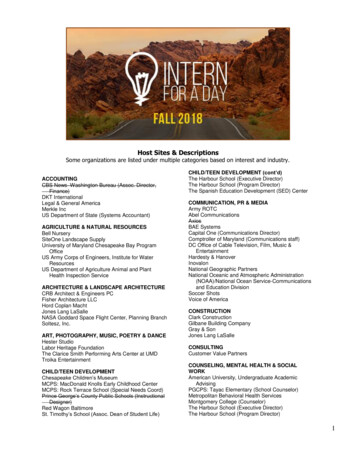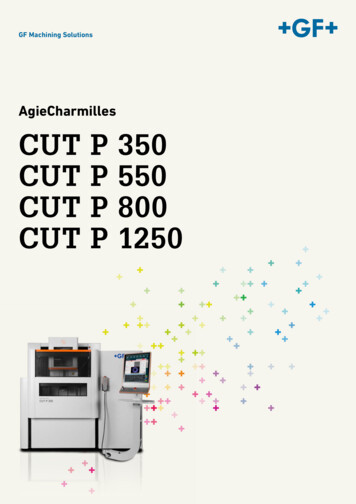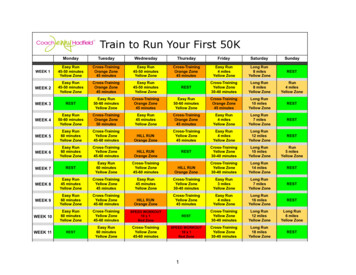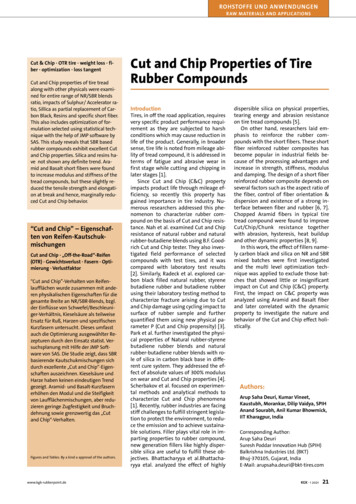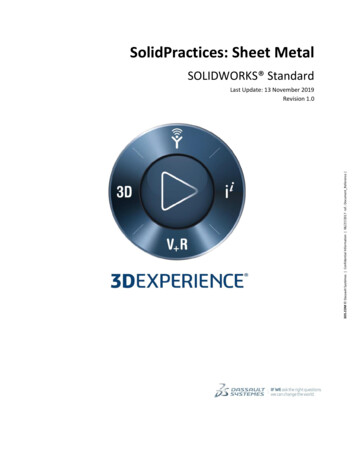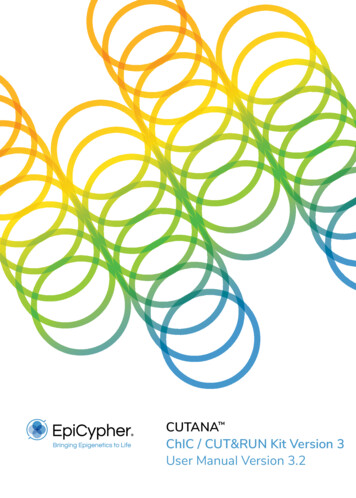
Transcription
CUTANA ChIC / CUT&RUN Kit Version 3User Manual Version 3.2
EpiCypher, Inc.PO Box 14453Durham, NC 27709www.epicypher.comPh: 1-855-374-2461 F: 1-855-420-6111Email: info@epicypher.comTech Support: techsupport@epicypher.comCopyright 2022 EpiCypher, Inc. All rights reserved.This document may not be duplicated in part or in its entirety without prior written consentof EpiCypher, Inc.EpiCypher and SNAP-ChIP are registered trademarks of EpiCypher. All other trademarksand trade names in this document are property of their respective corporations.
Kit Version 3User Manual Version 3.2CUTANATMChIC / CUT&RUN KitKit Version 3Catalog No. 14-104848 ChIC / CUT&RUN ReactionsUpon receipt, store indicated componentsat 4 C, -20 C and room temperature (RT)Stable for 6 months upon date of receipt.See p. 8-9 for storage instructions.
Table of ContentsOverview 5Background and Description 6Included in the Kit 8Materials Required but Not Supplied10Recommended Experimental Design 11Notes Before Starting 13Experimental Protocol: Day 1 14Section I: CUT&RUN Buffer Prep ( 30 min)14Section II: Bead Activation ( 30 min)15Section III: Binding Cells to Activated Beads ( 30 min)16Section IV: Antibody Binding ( 30 min overnight)16Experimental Protocol: Day 2 18Section V: Binding of pAG-MNase ( 30 min)18Section VI: Targeted Chromatin Digestion and Release ( 3 hrs)18Section VII: DNA Purification ( 30 min)19Experimental Protocol: Library Prep and NGS21Section VIII: NGS Library Prep ( 4 hrs)21Section IX: Analysis of Library Fragment Size ( 1 hr)21Section X: Illumina Sequencing 22 Section XI: Data Analysis 23Quality Control Checks 24Optimization of Cell Permeabilization24Cell/Nuclei Integrity and Bead Conjugation Check26Quality Control Checks Before Sequencing28Quality Control Checks After Sequencing29SNAP-CUTANA K-MetStat Panel 31Appendix I: Experimental Normalization Using E. coli Spike-in DNA36Appendix II: Protocol Variations37Appendix III: Frequently Asked Questions42Appendix IV: Safety Datasheet46References 52
OverviewCleavage Under Targets & Release Using Nuclease (CUT&RUN) is a revolutionarygenomic mapping strategy developed by the group of Dr. Steven Henikoff1. It buildson Chromatin ImmunoCleavage (ChIC) from Dr. Ulrich Laemmli2, wherein a fusionof Protein A to Micrococcal Nuclease (pA-MNase) is recruited to selectively cleaveantibody-bound chromatin in situ3. In CUT&RUN, cells or nuclei are immobilized toa solid support, with pAG-MNase cleaved DNA fragments isolated from solution.The workflow is compatible with next-generation sequencing (NGS) to provide highquality genome-wide profiles of histone post-translational modifications (PTMs) andchromatin-associated proteins (e.g. TFs and chromatin remodelers; Figure 1).Immobilize &permeabilize cells(or nuclei)Add antibody tohistone PTM orchromatin-interactingproteinAdd & activatepAG-MNaseto cleavetarget-DNA complexTarget-DNA complexdiffuses out,collect supernatantExtract DNA & preparesequencing libraryNext-generationsequencing anddata analysisFIGURE 1Overview of the CUTANA CUT&RUN protocol.5
Background and DescriptionHistorically, ChIP-seq is the leading approach for genome-wide mapping of histonePTMs and chromatin-associated proteins. In this approach, bulk chromatin isfragmented by sonication or enzymatic digestion. Target-specific fragments are thenimmunoprecipitated. Despite extensive optimization and stringent wash conditions,ChIP-seq requires large numbers of cells (typically 105 – 106 cells) and deepsequencing of both input chromatin and immunoprecipitated material (typically 30million reads each) to resolve signal from background.ChIC and CUT&RUN have revolutionized the study of chromatin regulation byenabling targeted release of genomic fragments into solution. With this innovation,background is dramatically reduced, allowing high resolution genomic mapping forhistone PTMs and chromatin-associated proteins using a small number of cells andFig 2 only 3-8 million sequencing reads per reaction (Figure 2). The streamlined workflowand cost savings make ChIC/CUT&RUN amenable to greater experimental throughput, allowing deeper and more rapid investigations to uncover epigenetic 0-95]TAL1STILCMPK1LINC01389 FOXD2FIGURE 2Representative genome browser tracks show CUTANA CUT&RUN results using 500,000 K562cells. Clear peaks with the expected distribution profile are observed using 3-8 million sequencingreads per reaction for a variety of epigenetic targets, including histone PTMs (H3K4me3, H3K27me3,H3K27ac), transcription factors (CTCF), epigenetic reader proteins (BRD4), writer enzymes (MLL1),and chromatin remodelers (SMARCA4). Rabbit IgG antibody is shown as a negative control (top track).
The CUTANA ChIC/CUT&RUN Kit contains materials for 48 reactions and isdesigned for multi-channel pipetting to realize the increased throughput advantageof CUT&RUN. The kit includes positive (H3K4me3) and negative (Rabbit IgG) controlantibodies, and an aliquot of the SNAP-CUTANA K-MetStat Panel (16 DNA barcoded designer nucleosomes carrying widely-studied lysine methylation PTMs).The K-MetStat Panel is spiked into control reactions to directly monitor experimentalsuccess and aid troubleshooting. Additionally, sheared E. coli DNA is added to allreactions after pAG-MNase cleavage to control for library prep and enable NGSnormalization. The kit is compatible with cells and nuclei, including cryopreservedand cross-linked samples (Figure 3). Although it is recommended to start with500,000 cells, comparable data can be generated using as few as 5,000 cells (Figure4). The inclusion of rigorous controls as well as compatibility with diverse targettypes, sample inputs, and cell numbers make the kit ideal for a variety of researchFig 3applications.FreshCellsHeatmaps showing CUT&RUN signal (red) andbackground (blue) of H3K4me3-enriched regionsflanking annotated transcription start sites (TSS, /- 2 kb). Gene rows are aligned across the conditions,showing that the genome-wide enrichment patternisFigpreservedacross sample types.4-2kbH3K4me3CrosslinkedCellsNuclei18,793 genes aligned to TSSFIGURE 3Freeze/ThawedCellsTSS 2kbH3K27me3# ][0-760][0-109]500k50k5k0.5kFIGURE 4DGCR8TRMT2A RANBP1ZDHHC8LOC284865RTN4RRepresentative genome browser tracks for H3K4me3 (low abundance target) and H3K27me3 (highabundance target) CUT&RUN experiments using decreasing amounts of K562 cells. At 5,000 cells,data quality is largely indistinguishable from standard conditions (500,000 cells).7
Included in the KitKit components are stable for 6 months upon date of receipt. Store as outlined below.Store at 4 C upon receipt:ItemCatalog No.Notes before useConA Beads21-1401DO NOT FREEZE. Concanavalin A (ConA) beads areused for immobilizing cells or nuclei. ConA can causeimmune cell activation. For immune cell studies, usenuclei as input (see Appendix II).E. coli Spike-inDNA18-1401100 ng lyophilized E. coli DNA for NGS normalization.Before first use, quick spin and reconstitute in200 μL DNase-free water (0.5 ng/μL).NOTE: After reconstitution, store at -20 C.Bead ActivationBuffer21-1001Use to prepare ConA beads prior to sampleimmobilization.Pre-Wash Buffer21-1002Use to prepare Wash, Cell Permeabilization,and Antibody Buffers FRESH for each experiment.Stop Buffer21-10033X concentration. Use to terminatepAG-MNase cleavage activity.Store at -20 C upon receipt:ItemCatalog No.Notes before use5% Digitonin21-1004Use to prepare Cell Permeabilization Buffer FRESHfor each experiment. Final digitonin concentrationshoud be optimized for each sample type;see Quality Control Checks section.1 M Spermidine21-10052,000X concentration. Use to prepare Wash BufferFRESH for each experiment.pAG-MNase15-1016Proteins A and G (pAG) are compatible with a varietyof antibody isotypes.H3K4me3 PositiveControl Antibody13-0041kSMALL VOLUME: quick spin before use. Sufficientvolume for 10 reactions. Use as a positive controlalongside targets of interest in every experiment.Rabbit IgGNegativeControl Antibody13-0042kSMALL VOLUME: quick spin before use. Sufficientvolume for 10 reactions. Use as a negative controlalongside targets of interest in every experiment.SNAP-CUTANA K-MetStat Panel19-1002kSMALL VOLUME: quick spin before use.Pipette to resuspend beads; DO NOT VORTEX.Panel of biotinylated designer nucleosomes coupledto streptavidin-coated magnetic beads. Sufficientvolume for 20 reactions. Use as a spike-in control withH3K4me3 and IgG control antibodies. See QualityControl Checks section.
Store at room temperature (RT) upon receipt:ItemCatalog No.Notes before use8-strip Tubes10-0009kCompatible with multi-channel pipettors andMagnetic Separation Rack (EpiCypher 10-0008).DNA CleanupColumns10-0010Use with the DNA Collection Tubes.DNA CollectionTubes10-0011Use with the DNA Cleanup Columns.0.5 M EDTA21-1006250X concentration. Use to prepare AntibodyBuffer FRESH for each experiment.100 mM CalciumChloride21-1007When added to reactions, this will activatechromatin tethered pAG-MNase to cleave DNA.DNA Binding Buffer21-1008Before first use, add 6.9 mL isopropanol.WARNING: Contains toxic ingredients(see Appendix IV).DNA Wash Buffer21-1009Before first use, add 20 mL 95% ethanol.DNA Elution Buffer21-1010Recover final CUT&RUN DNA in 6 – 20 μLdepending on desired final concentration.9
Materials Required but Not SuppliedREAGENTS: Antibody to target of interest (user-dependent). See FAQs for more information.* NOTE: EpiCypher continues to conduct extensive investigations of antibody performance4.Visit epicypher.com/cut-and-run-antibodies to browse our validated CUT&RUN antibodies. I f mapping a histone methyl-lysine PTM, we strongly recommend adding theSNAP-CUTANA K-MetStat Panel (EpiCypher 19-1002) to each reaction. rotease inhibitor (e.g. cOmplete , EDTA-free Protease Inhibitor Cocktail,PRoche 11873580001) 0.4% Trypan blue (e.g. Invitrogen T10282) Isopropanol UTANA CUT&RUN Library Prep Kit, 48 reactions (EpiCypher 14-1001 &C14‑1002)* NOTE: The two versions of this kit (14-1001 & 14-1002) contain distinct primer sets,allowing up to 96 CUT&RUN libraries to be multiplexed when kits are used together.EQUIPMENT: 1.5, 15 and 50 mL tubes Magnetic Separation Racks for 1.5 mL tubes (EpiCypher 10-0012) and 8-stripTubes (EpiCypher 10-0008) Qubit 4 Fluorometer (Invitrogen Q33238) and 1X dsDNA HS Kit (Q33230) apillary electrophoresis machine and required reagents (e.g. Agilent TapeStation Cand D1000 ScreenTape 5067-5582 & D100 Reagents 5067-5583, or AgilentBioanalyzer and High Sensitivity DNA Analysis Kit 5067-4626) -channel multi-channel pipettor (e.g. VWR 76169-250) and multi-channel8reagent reservoirs (e.g. Thermo Fisher Scientific 14-387-072) Vortex (e.g. Vortex-Genie , Scientific Industries SI-0236) Thermocycler (e.g. from BioRad, Applied Biosystems, Eppendorf) Tube nutator for incubation steps (e.g. VWR 82007-202)* IMPORTANT: It is critical to use a nutator rather than a rotator to keep liquid in tube conicalbottom and avoid bead drying.
Recommended Experimental DesignKey Points to Consider: Optimize conditions and become familiar with the CUT&RUN workflow using acontrol cell line (e.g. K562 cells) and antibody (e.g. H3K4me3). Always include reactions with positive (H3K4me3) and negative (IgG) controlantibodies, spiked with the SNAP-CUTANA K-MetStat Panel. This is especiallycritical when optimizing assays for new experimental conditions (e.g. new cell types,reduced inputs) and targets, but should also be included as standard control forcontinuous monitoring of assay success.DESIGNING A SUCCESSFUL CUT&RUN EXPERIMENT:1. Select cell types/input amount. Always start with 500,000 cells before reducing cell number. his protocol is designed for non-adherent (suspension) cell lines. For other inputTtypes, including adaptations for adherent cells, nuclei, cryopreserved samples,tissues, and cross-linked materials, see Appendix II. 562 cells can be used as a control cell line, if desired. They are known to beKpermeabilized under standard digitonin concentration and reference data areavailable for comparison.* NOTE: This protocol was optimized using 500,000 human K562 cells, but is compatible withas few as 5,000 cells. See guidelines on optimization for reduced inputs below.2. Include the proper controls in every experiment. lways include reactions designated for positive (H3K4me3) and negativeA(IgG) control antibodies, included with the kit. Control antibodies should be used with the SNAP-CUTANA K-MetStat Panel(see Quality Control Checks section). Combined, these controls provide a directreadout of experimental success and are a powerful tool in assay development.* IMPORTANT: If NGS results for controls match expected profiles, but data for experimentaltargets are unsatisfactory, optimization may be necessary (e.g. cell number, sample preparation,antibody concentration/vendor). EpiCypher Technical Support (techsupport@epicypher.com)will request data from control antibodies and spike-ins to assist troubleshooting.11
3. Select experimental antibodies. or targets of interest, try EpiCypher's CUT&RUN validated antibodiesF(epicypher.com/cut-and-run-antibodies), inquire at techsupport@epicypher.comfor antibody recommendations, or source multiple antibodies (3-5) to the sametarget to test performance in CUT&RUN.* NOTE: Antibody performance can vary dramatically lot-to-lot. Every lot of EpiCypherCUT&RUN validated antibodies are tested directly in-application.* IMPORTANT: Antibodies that work well in ChIP-seq do not guarantee success in CUT&RUN.This kit has been validated for genomic profiling of: Histone PTMs (e.g. lysine methylation, acetylation, and ubiquitylation) Transcription factors (e.g. CTCF, FOXA1, GATA3) Chromatin remodelers (e.g. ATPase subunits of SWI/SNF, ISWI, INO80, CHD) Chromatin writers & readers (e.g. MLL1, BRD4) Epitope-tagged proteins (e.g. HA, FLAG tags)4. Use spike-in controls for targets of interest whenever possible. The K-MetStat Panel can be added to any reactions profiling methyl-lysinePTMs, for in-assay antibody validation and workflow standardization. Thiswould require additional K-MetStat Panel, available at epicypher.com/19-1002. E .coli Spike-in DNA can be added for any CUT&RUN target to aid in NGSnormalization (Appendix I).OPTIMIZING FOR REDUCED INPUTS1. Start by optimizing the protocol using 500,000 native cells and control antibodieswith the SNAP-CUTANA K-MetStat Panel of spike-in controls.2. Then optimize for experimental conditions (e.g. cross-linking) and target of interest.Include control antibodies with the K-MetStat Panel to monitor assay success.3. Once conditions are optimized for the target and cell type of interest, scale downto desired number of cells. Without any further modifications, this protocol hasbeen validated on as few as 5,000 K562 cells (see Note, below).* NOTE: Compatibility with low inputs depends on many factors, including antibody quality(i.e. specificity, efficiency) and target abundance in cells. For instance, primary cells often havedifferent target abundance vs. cell lines, which can impact data quality at low cell numbers.
Notes Before Starting1. Use the minimal amount of Digitonin required for efficient cell permeabilization toavoid precipitation and cell lysis. This should be empirically determined for everysample type. See Quality Control Checks for instructions and example results.2. Ensure starting cells/nuclei are of sufficient quality for CUT&RUN and confirmbinding to ConA beads. See Quality Control Checks for guidelines.*IMPORTANT: We strongly recommend performing these steps for every experiment.3. ConA Beads dry out easily, which can result in sample loss. To avoid this problem: Use a nutator, which gently shakes or rocks tubes without full rotation. This willprevent beads sticking to the sides or caps of the tube and drying out. Note steps that indicate when to pipette or vortex to disperse bead clumps.4. Although protocols with shortened incubation times have been published3, suchchanges can adversely impact yield and reproducibility, and are not recommended.5. This protocol has been adapted to 8-strip Tubes and multi-channel pipettes,enabling higher throughput and improved assay reproducibility.6. The DNA Cleanup Columns are designed to capture DNA fragments as small as50 bp, which is adequate for most chromatin targets, including TFs (see FAQs).7. T he best indicator of assay success prior to NGS is enrichment of mononucleosomefragments in final CUT&RUN libraries ( 300 bp with adapters). Raw yields ofpurified CUT&RUN DNA may be considered; see Quality Control Checks. *IMPORTANT: We do not recommend fragment distribution analysis (e.g. Bioanalyzer ,TapeStation ) or qPCR of purified CUT&RUN DNA before library prep. See FAQs for discussion.8. Paired-end sequencing (min 50 bp) is recommended for CUT&RUN. This ensuresaccurate alignment to the K-MetStat Panel and provides information on DNAfragment sizes, enabling bioinformatic filtering and DNA footprinting (e.g. for TFs).9. It is recommended to prep CUT&RUN sequencing libraries using the CUTANA Library Prep Kit (EpiCypher 14-1001 & 14-1002), which has been specificallydeveloped to deliver a streamlined, user-friendly, and robust CUT&RUN workflow.10. In CUT&RUN, 3-8 million sequence reads provides adequate coverage for mosttargets. See Quality Control Checks for additional CUT&RUN validation metrics.13
Experimental Protocol: Day 1SECTION I: CUT&RUN BUFFER PREP ( 30 MIN)* NOTE: Make buffers FRESH the first day of the CUT&RUN experiment (Figure 5). Volumesare per planned CUT&RUN reaction and include overfill to account for pipetting error. See table(next page) for scaling buffer volumes with multiple reactions.FIGURE 5Schematic of buffers to be prepared fresh the day of use. RT, room temperature.A. Gather all reagents stored at 4ºC and -20ºC needed for Day 1 (ConA Beads, BeadActivation Buffer, Pre-Wash Buffer, Digitonin, Spermidine, H3K4me3 and IgGControl Antibodies, K-MetStat Panel). Place on ice to thaw or equilibrate.B. Add 1.8 mL Pre-Wash Buffer per reaction to a conical tube labeled Wash Buffer.C. Dissolve 1 protease inhibitor tablet (Roche) in 2 mL water (25X stock). Add 72 μLper reaction to the Wash Buffer. Store remaining 25X stock 12 weeks at -20ºC.D. Dilute 1 M Spermidine 1:2,000 in the Wash Buffer. Store final buffer at RT.E. In a new tube labeled Cell Permeabilization Buffer, transfer 1.4 mL Wash Bufferper reaction. Add 5% Digitonin at a 1:500 dilution (see Note, below).* NOTE: A 1:500 dilution (0.01% digitonin) is optimal for permeabilizing K562, MCF7, andA549 cells. For other cell types, optimize conditions as detailed in Quality Control Checks.
F. Transfer 100 µL Cell Permeabilization Buffer per reaction to a new tube labeledAntibody Buffer. Add 0.5M EDTA (1:250 dilution). Store final buffer on ice.G. S tore remaining Cell Permeabilization Buffer at 4 C overnight for use on Day 2.Buffer Sample Scaling Calculations:NUMBER OF REACTIONS1X8X16X1.8 mL14.4 mL28.8 mL25X Protease Inhibitor72 µL576 µL1.15 mL1 M Spermidine0.9 µL7.2 µL14.4 µLWash Buffer - store at RT for use on Day 1Pre-Wash BufferCell Permeabilization Buffer - store at 4ºC for use on Day 2Wash Buffer1.4 mL11.2 mL22.4 mL5% Digitonin2.8 µL22.4 µL44.8 µLAntibody Buffer - store on ice for use on Day 1Cell Permeabilization Buffer100 µL800 µL1.6 mL0.5 M EDTA0.4 µL3.2 µL6.4 µLSECTION II: BEAD ACTIVATION ( 30 MIN)1. Gently resuspend the ConA Beads by pipetting. Transfer 11 μL beads per plannedCUT&RUN reaction to a 1.5 mL tube for batch processing.* NOTE: Batch processing is recommended to improve handling and consistency acrossreactions. If a 1.5 mL tube magnet is not available, the beads can be processed individually(10 μL/reaction) in the provided 8-strip Tubes using a compatible 8-strip magnet.2. Place the tube on a magnet until slurry clears and pipette to remove supernatant.* IMPORTANT: For all steps involving magnetic racks, take care to avoid disturbing theimmobilized beads with pipette tips.3. Immediately add 100 μL/reaction cold Bead Activation Buffer to avoid drying outthe beads. Remove tube from magnet, and pipette gently to mix.4. Place the tube on a magnet until slurry clears and pipette to remove supernatant.Repeat previous step for total of two washes.5. Resuspend beads in 11 μL/reaction cold Bead Activation Buffer.*NOTE: If not batch processing, use 10 μL/reaction at this step. Proceed directly to Section III.6. Aliquot 10 μL/reaction of activated beads into 8-strip Tubes. Keep on ice.15
SECTION III: BINDING CELLS TO ACTIVATED BEADS ( 30 MIN)* NOTE 1: For sample inputs other than native suspension cells (e.g. adherent cells,cryopreserved cells, tissue, nuclei, and cross-linked cells) see Appendix II.* NOTE 2: Determine cell/nuclei integrity before and after conjugation to ConA beads. SeeQuality Control Checks: Cell/Nuclei Integrity and Bead Conjugation Checks.* IMPORTANT: Beads are prone to clumping; frequently vortex/pipette to even suspension.7. Harvest 500,000 cells per planned CUT&RUN reaction. If more than one reactionis planned, process all cells together at this step. Centrifuge at 600 x g, 3 min atRT, in a 1.5 mL tube. Decant or pipette to remove supernatant.8. Resuspend cells in 100 μL/reaction RT Wash Buffer. Pipette to thoroughlyresuspend. Centrifuge at 600 x g, 3 min, RT. Decant or pipette to removesupernatant.9. Repeat the previous step for total of two washes.10. Resuspend cells in 105 μL/reaction RT Wash Buffer. Thoroughly pipette to mix.* NOTE: Assess integrity of prepared cells or nuclei; see Quality Control Checks.11. Aliquot 100 μL washed cells to each 8-strip tube containing 10 μL of activatedbeads. Gently vortex and/or pipette until evenly resuspended.12. Incubate cell-bead slurry on benchtop for 10 min at RT to adsorb cells to beads.* NOTE: Evaluate success of cell binding to beads; see Quality Control Checks.SECTION IV: ANTIBODY BINDING ( 30 MIN OVERNIGHT)13. If using a multi-channel pipette (recommended) place a multi-channel reagentreservoir on ice.* NOTE: Multi-channel pipetting is highly recommended through the rest of the experiment.This helps to avoid bead dry out, improves yield, and increases experimental throughput.* IMPORTANT: If processing 8 reactions (multiple 8-strip tubes), remove & replace bufferfor a single strip before processing the next to avoid drying out beads during wash steps.14. Place the 8-strip tubes on an 8-strip magnet (high volume setting) until slurryclears. Pipette to remove supernatant; avoid disturbing beads with tip.15. Immediately add 50 μL cold Antibody Buffer to each reaction to prevent beadsfrom drying. Gently vortex to an even resuspension.
16. For CUT&RUN reactions designated for positive (H3K4me3) and negative (IgG)control antibodies, the SNAP-CUTANA K-MetStat Panel is spiked-in BEFOREaddition of antibody. To add nucleosome spike-ins:a. Perform a quick spin and then gently mix the K-MetStat Panel by pipetting(do not vortex) to thoroughly resuspend nucleosomes and magnetic beads.b. Add 2 µL of the SNAP-CUTANA K-MetStat Panel per 500,000 cells (seeNote 1 below for lower cell inputs). Gently vortex or pipette to mix.* NOTE 1: For less than 500,000 cells, decrease the amount of K-MetStat Panel linearly bypreparing a working stock dilution of the panel in Antibody Buffer. This should be preparedFRESH the day of the experiment and discarded after use. Starting recommendations areprovided in the Table below, but optimization may be required for user-specific conditions;see the SNAP-CUTANA Spike-in User Guide (epicypher.com/19-1002).Number ofcellsWorking stockdilutionVolume addedto reactionFinal dilution500,000Stock2 µL1:25250,0001:22 µL1:50100,0001:52 µL1:12550,000 or less1:102 µL1:250* NOTE 2: The K-MetStat Panel and control antibodies provide a defined control to ensureassay conditions are optimized (see Quality Control Checks). We also recommend addingthe K-MetStat Panel to all experimental reactions targeting histone lysine methylation PTMs;a 50-reaction pack size is available at epicypher.com/19-1002.17. Add 0.5 μg antibody to each reaction and gently vortex to mix.* IMPORTANT: H3K4me3 and IgG control antibodies are provided at 0.5 mg/mL; add 1.0 µLto designated control reactions.* NOTE: Some antibodies are stored in glycerol solution and may be viscous. Take care toensure accurate pipetting (e.g. aspirate slowly, check tip for accuracy, pipette up and down three times into CUT&RUN reactions to clear any reamining glycerol from tip).18. Incubate 8-strip tubes on nutator (capped ends elevated) overnight at 4ºC.* IMPORTANT: DO NOT ROTATE TUBES. Prop the tubes such that capped ends are slightlyelevated (30 angle) to keep bead suspension in conical bottom and prevent bead drying.19. Store the Cell Permeabilization Buffer at 4 C overnight for use on Day 2.17
Experimental Protocol: Day 2SECTION IV: ANTIBODY BINDING, CONTINUED ( 10 MIN)20. If using a multi-channel pipette (recommended) place a multi-channel reagentreservoir on ice. Fill with Cell Permeabilization Buffer.* IMPORTANT: If processing 8 reactions (more than one 8-strip tube), for subsequent washsteps remove & replace supernatants for a single strip before processing the next strip. Thisavoids bead dry out during wash steps.21. Remove 8-strip tubes from overnight incubation and place on magnet untilslurry clears. Pipette to remove supernatant.* NOTE: Some settling of ConA beads may occur during overnight incubation.22. Keeping 8-strip tubes on magnet, add 200 μL cold Cell Permeabilization Bufferdirectly onto beads. Pipette to remove supernatant.23. Repeat previous step for total of two washes, without removing 8-strip tubesfrom the magnet.24. Add 50 μL cold Cell Permeabilization Buffer to each reaction, and remove tubesfrom magnet. Gently vortex to mix and disperse clumps by pipetting.SECTION V: BINDING OF PAG-MNASE ( 30 MIN)25. Add 2.5 μL pAG-MNase (20x stock) to each reaction. Vortex/pipette to mix.* IMPORTANT: To evenly distribute enzyme across cells/nuclei, ensure beads are thoroughlyresuspended by gentle vortexing and/or pipetting with a P200.26. Incubate reactions for 10 min at RT. Return 8-strip tube to magnet. Pipette toremove supernatant.27. Keeping 8-strip tubes on the magnet, add 200 μL cold Cell PermeabilizationBuffer directly onto beads. Pipette to remove supernatant.28. Repeat previous step for total of two washes without removing 8-strip tubesfrom the magnet.29. Add 50 μL cold Cell Permeabilization Buffer to each reaction, and remove tubesfrom magnet. Gently vortex to mix and disperse clumps by pipetting.SECTION VI: TARGETED CHROMATIN DIGESTION AND RELEASE ( 3 HRS)30. Place 8-strip tubes on ice. Add 1 μL 100 mM Calcium Chloride to each reactionand gently vortex to mix. Ensure efficient digestion by making sure beads arethoroughly resuspended. Gently pipette with a P200 if needed.
31. Incubate 8-strip tubes on nutator (capped ends elevated) for 2 hours at 4ºC.32. Prepare a Stop Buffer Master Mix by adding E. coli Spike-in DNA to Stop Buffer:a. P rior to first use, pellet lyophilized DNA by quick spin in a benchtop microfuge.Reconstitute in 200 μL DNase free water; vortex tubes on all sides to ensurecomplete resuspension. Store at -20 C after reconstitution.b. To prepare master mix: add 1 µL (0.5 ng) E. coli Spike-in DNA to 33 µL StopBuffer per CUT&RUN reaction. Pipette or gently vortex to mix.* NOTE: In general, aim for E. coli Spike-in DNA to comprise 0.5 – 5% (ideally 1%) of totalread counts in sequencing data. While 0.5-1 ng works for most cell types and conditions,this may need to be adjusted depending on cell number, antibody, etc. See Appendix I.33. At the end of the 2 hour incubation, add 33 µL Stop Buffer Master Mix to eachreaction and gently vortex to mix.34. Incubate 8-strip tubes for 10 min at 37ºC in a thermocycler.* NOTE: This step releases cleaved chromatin to supernatant and degrades RNA.35. Perform a quick spin of 8-strip tubes in a benchtop microfuge.36. Place 8-strip tubes on a magnet until slurry clears. Transfer supernatantscontaining CUT&RUN enriched DNA to 1.5 mL tubes and discard ConA Beads.SECTION VII: DNA PURIFICATION ( 30 MIN)* NOTE: The DNA Cleanup Columns will retain fragments 50 bp. For recommendationsregarding smaller fragment size enrichment for TF binding studies, see FAQs.37. Prior to first use, add 6.9 mL isopropanol to DNA Binding Buffer.38. Add 420 μL DNA Binding Buffer to each reaction. Mix well by vortexing.39. For every CUT&RUN reaction, place a DNA Cleanup Column into a DNACollection Tube. Load each reaction onto a column and label the top.40. Centrifuge at 16,000 x g, 30 sec, RT. Discard the flow-through. Place the columnback into the collection tube.* NOTE: A vacuum manifold can be used in place of centrifugation. For each step, add theindicated buffer, turn the vacuum on, and allow the solution to pass through the columnbefore turning the vacuum off.41. Prior to first use, add 20 mL 95% ethanol to DNA Wash Buffer.42. Add 200 μL DNA Wash Buffer to each column.19
SECTION VII: DNA PURIFICATION ( 30 MIN), CONTINUED43. Centrifuge at 16,000 x g, 30 sec, RT. Discard the flow-through. Place the columnback into the collection tube.44. Repeat for a total of two washes.45. Discard the flow-through. Centrifuge one additional time at 16,000 x g, 30 secto completely dry the column.46. Carefully remove the column from the collection tube, ensuring it does notcontact the flow-through. Transfer column to a clean pre-labeled 1.5 mL tube.47. Elute CUT&RUN DNA by adding 12 μL DNA Elution Buffer, taking care to ensurethe buffer is added to the center of the column rat
Qubit 4 Fluorometer (Invitrogen Q33238) and 1X dsDNA HS Kit (Q33230) Capillary electrophoresis machine and required reagents (e.g. Agilent TapeStation and D1000 ScreenTape 5067-5582 & D100 Reagents 5067-5583, or Agilent Bioanalyzer and High Sensitivity DNA Analysis Kit 5067-4626)
